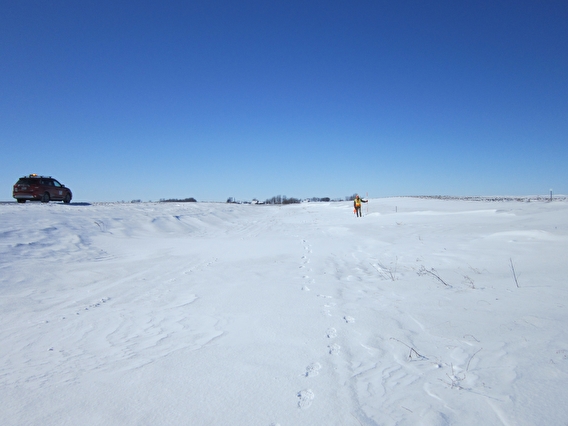Roads need to be kept clear of snow and ice in winter for obvious safety reasons, but using road salt to do so comes with huge downsides—namely, damage to the environment, infrastructure, and human health. Winter maintenance experts are looking into road design strategies that require less salt because they leverage the surrounding environment to keep roads clear.
Dan Gullickson is the blowing snow supervisor for the Minnesota Department of Transportation. As part of the 2023 Salt Symposium, he gave a presentation on drift-free road and ditch design.
The goal, Gullickson said, is to design roads that naturally mitigate snow drifting and make it easier for plows to remove snow from the pavement. He recommends using snow fences to stop the wind—particularly when the road is near a wide-open field—and building roads about three feet higher than the surrounding topography so that snow is less likely to blow up and out of the ditches.

Ditches also need to be designed for snow storage. Building them wide with good drainage is important, Gullickson said, and it is advisable to plan for snow piles that don’t bury important road infrastructure such as signs and guardrails. If possible, it is also generally a good idea to build ditches downwind of the road to prevent snow from blowing back over the pavement.
“Where we’ve introduced these wider ditches where we saw known problems,” Gullickson said, “we have found that we can really prevent that snow drift from encroaching onto the shoulder of the road.”
Caleb Dobbins, chief highway engineer at the City of Manchester Department of Public Works in New Hampshire, emphasized a more sun-oriented approach to reducing road ice during his presentation.
Road salt, according to the New Hampshire Department of Environmental Services, is only effective when the surface of the pavement reaches 15 degrees Fahrenheit. Dobbins’ strategy, therefore, is to clear surrounding trees and get sunlight onto the road as early and for as long as possible to maximize the road salt’s effectiveness.
It is not a one-size-fits-all solution, Dobbins warned. He acknowledged that trees are important mwind breaks for preventing snow drifting, so he recommended pulling the tree line back by about 50 feet—especially in very flat areas. The type of tree also needs to be considered; deciduous trees drop their leaves in the winter, so they block less sunlight than evergreens. He also recommended only cutting trees to the south and east of the road, since winter sunlight tends to come from the south, and morning light from the east gets the warming process started earlier.
“By being able to get sunlight onto the road that much quicker,” Dobbins said, “that’s what I’ll call the best ‘solar salt’ in the world.”
Chris Ohm was formerly the chief of roadside facilities and program management with the Wisconsin Department of Transportation. During his symposium presentation, he took an even broader look at how road design interacts with the surrounding environment and emphasized the need for better communication between road designers and road maintenance workers.
Topography, climate, soil conditions, and even the texture of the pavement itself can have a huge impact on how a road behaves in winter, Ohm said. Rivers tend to generate a lot of air moisture, and rock faces often leak water—both of which can translate into ice. If the soil underneath the pavement retains a lot of moisture, it might be more susceptible to frost heave, and pavements that have been profiled by diamond grinding can leave fins behind, catching snow to form ice.
Road designers and engineers, Ohm said, often do not take these factors into consideration because they are not around long enough to see the long-term effects of their designs. By contrast, maintenance professionals usually live locally—often have their entire lives—and can observe how the design interacts with the environment over multiple years.
For example, Ohm said, US Highway 12 in Sauk County, Wisconsin, is a road that behaves normally most years. A particularly wet year, however, can activate local springs and result in water bubbling up through the roads to form ice. Careful road design can mitigate a problem like this, but only if the designer knows about the problem.
“(Maintenance professionals) have a lot of insight that, as an engineer or as a designer, you don’t always think about,” Ohm said.
The 2023 Salt Symposium was livestreamed online in August, and the event was sponsored by Bolton & Menk. The 2024 Salt Symposium will be Aug. 6–7; learn more to register, register, submit an abstract to speak, or nominate an individual or organization for an award.
—Sophie Koch, contributing writer